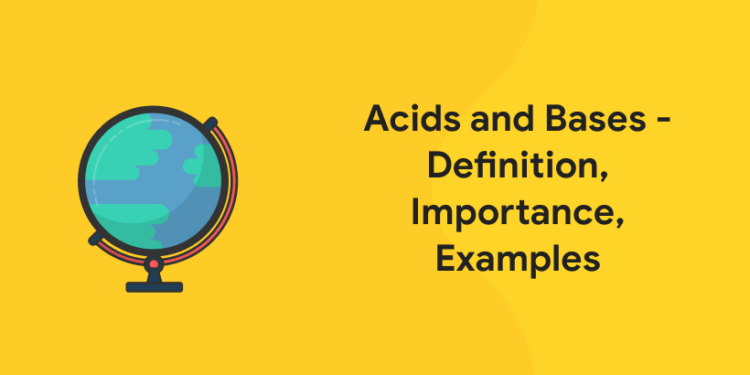Table of Contents
Acids and bases are prevalent chemicals that are known for their interaction with each other which results in the formation of new substances. The formation of salt and water is the byproduct of the acid-base interaction. Want to know more about acids and bases? Keep on reading!
Acids and Bases: Definition
The formation of salt and water is the byproduct of the acid-base combination. The term acid comes from the Latin phrase ‘acere’ which implies ‘sour’. An acid is any hydrogen-containing essence that is competent in contributing a proton (hydrogen ion) to another essence. A base is a molecule or ion capable of deriving a hydrogen ion from an acid. Acidic substances are determined by their putrid flavor. An acid is a molecule that can contribute an H+ ion and can stay vigorously fine after a drubbing of H+. Bases are distinguished by a sore tidbit and a sly consistency.
A base that can be liquefied in moistness is directed as an alkali. When these essences chemically respond with acids they generate salts automatically. Acids are usually known for their capacity to turn blue litmus red whereas bases are capable of turning red litmus paper into the blue. The acidity or basicity of a substance and its numeric value can find out by using the pH scale or the Potential of Hydrogen scale can be used for the purpose. The pH scale is the entrusted general practice to estimate how acidic or basic an essence is. A pH ranking measurement can differ from 0 to 14. The numerical value of 0 is the most acidic and 14 is the most basic essence as per the estimation. The next popular way to check the acidic or basic essence is by the use of litmus paper. Blue litmus paper changes red under acidic circumstances and red litmus paper turns blue under basic or alkaline circumstances.
Three different approaches have been put forward by the scientists to come across a valid definition for acid-base combination. It is a difficult task to define acid and base precisely. It is important to know all the aspects of acids and bases based on the definitions. These hypotheses include the Bronsted-Lowry theory, Arrhenius theory, and the Lewis theory of acids and bases. Those who are looking for the three distinct theories on acids and bases can refer to the description given below.
Arrhenius’s theory of acids and bases declares that an acid induces H+ ions in a solution whereas a base begets an OH– ion in its solution. The Bronsted-Lowry theory describes an acid as a proton donor and a base as a proton acceptor. The Lewis definition of acids and bases explains acids as electron-pair acceptors and bases as electron-pair donors. The further explanations of acids and bases find their expression in these base theories.
Ace to the difference between virus and malware here!
The phrases acid and base are described in diverse modes, counting on the precise method of examining the effects of acidity and basicity. Arrhenius was the first chemist to define the concepts of acid and base. Arrhenius characterized acids as combinations that ionize to yield hydrogen ions and bases as combinations that ionize to assemble hydroxide ions. As per the Lowry-Bronsted description, an acid is a proton patron and a base is a proton acceptor. Now let’s take a look at Lewis’ definition of acids as molecules or ions competent for blending with unshared electron pairs, and bases are molecules or ions containing unshared electron pairs obtainable for disseminating with acids. If a molecule is electron deficient, according to Lewis’ description, it is deemed as acidic. This is regarded as one of the prevailing acid-base concepts. It is believed that All Lowery Bronstead acids are Lewis acids. Many of the other reagents such as boron trifluoride, aluminum chloride, etc. are also included in the Lewis definition of acids.
Difference between Acids and Bases
1: Who was the first woman President of India?
Here are some basic differences between acids and bases. Acid can produce hydrogen ions when disbanded in water. Whereas Bases can only produce hydroxyl ions when disbanded in water. Acids are capable of turning blue litmus paper into the red. Bases on the other hand turn red litmus paper into the blue. Acids are known for their sour taste and bases are known for their bitter flavor and buttery/soapy presence. The pH value of acid ranges from 1 to 7 on the PH scale whereas the pH value of base ranges from 7 to 14. Examples of Acids include HCl, H2SO4, etc., and bases such as NaOH, KOH, etc. are known for their amazing property.
Ace to UGC NET general paper video course here!
Free UPSKILLING Courses!
Take your first step toward mastering in-demand skills, acing interviews, and securing top-tier jobs with Entri's free upskilling courses.
Start Learning!Properties of Acids and Bases
The Acids are caustic. They are good conductors of electricity. Their pH markdowns are consistently less than 7. When responding to metals, these essences yield hydrogen gas. Acids are rotten in flavor. The bitter taste is the major property of all the bases. The bases are in general slippery, too. The bases lead to electricity because they consist of levied particles in the solution when it is in touch with water. The soapy texture is the other property of the base. The release of the hydroxide ions and the efficiency as a good conductor of electricity distinguishes bases from acids.
Examples for Acids and Bases
Examples of acids include Sulfuric acid [H2SO4], Hydrochloric acid [HCl], and Acetic acid [CH3COOH]. Popular examples for bases include sodium hydroxide [NaOH], milk of magnesia [Mg(OH)2], and calcium hydroxide [Ca(OH)2].
Acids and Bases: Importance
Vinegar, a watery solution of acetic acid is used as a food preservative. Citric acid is an essential part of lemon juice and orange juice. Citric acid can help in food preservation. Sulphuric acid is used as a key component in batteries. Automobile industries function with the help of batteries and thereby with the help of acids. The industrial exposition of explosives, colorants, dyes, and fertilizers involves the use of sulphuric acid and nitric acid. Phosphoric acid is a key component in soft drinks.
Free UPSKILLING Courses!
Take your first step toward mastering in-demand skills, acing interviews, and securing top-tier jobs with Entri's free upskilling courses.
Start Learning!Uses of Acids and Bases
The soap and paper manufacturing implicates the usefulness of sodium hydroxide. NaOH is also used in rayon manufacture. Ca(OH)2, also widely known as slaked lime or calcium hydroxide, is employed to fabricate bleaching powder. Dry compounds used in illustration or adornment are created with the usefulness of calcium hydroxide. Magnesium hydroxide is employed as a laxative. It also lessens any extra acidity in the mortal belly. It is used as an antacid. Ammonium hydroxide is a reagent employed in laboratories.
Those candidates who are preparing for any of the competitive exams should find the above materials as important study materials as the number of competent for every exam is increasing. The Entri App can help the candidates to update themselves on the latest details and information. The candidates can trust the experts in the Entri App who can help in various ways to achieve progress and growth.













